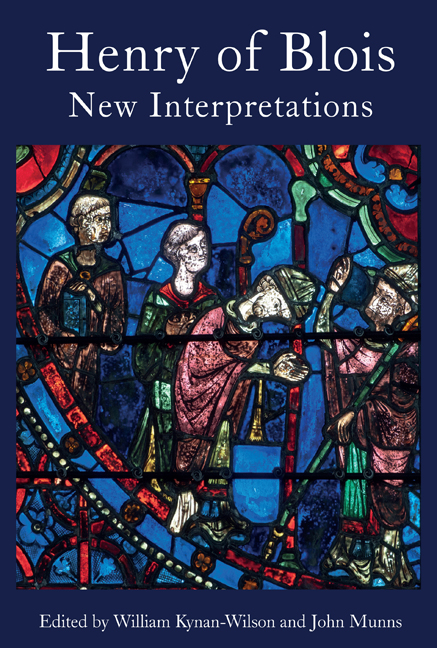Book contents
- Frontmatter
- Dedication
- Contents
- List of Illustrations
- List of Contributors
- Acknowledgements
- List of Abbreviations
- Genealogical Table: The Family Connections of Henry of Blois
- Introduction: Approaches to Henry of Blois
- 1 Causa Dei Et Ecclesie Cluniacensis: Henry of Blois and Cluny
- 2 Henry of Blois and His Legation in England
- 3 The Episcopal Colleagues of Henry of Blois
- 4 The Architectural Heritage of Bishop Henry of Blois at Winchester Cathedral
- 5 Wolvesey: Henry of Blois’ Domus Quasi palatium in Winchester
- 6 Bishop Henry’s Bible
- 7 Henry of Blois and the Construction of Roman Identity
- 8 Henry of Blois: Between Patronage and Representation in the Long Twelfth Century
- 9 The Last Days of Henry of Blois
- Timeline
- Bibliography
- Index
- Plate Section
4 - The Architectural Heritage of Bishop Henry of Blois at Winchester Cathedral
Published online by Cambridge University Press: 09 February 2021
- Frontmatter
- Dedication
- Contents
- List of Illustrations
- List of Contributors
- Acknowledgements
- List of Abbreviations
- Genealogical Table: The Family Connections of Henry of Blois
- Introduction: Approaches to Henry of Blois
- 1 Causa Dei Et Ecclesie Cluniacensis: Henry of Blois and Cluny
- 2 Henry of Blois and His Legation in England
- 3 The Episcopal Colleagues of Henry of Blois
- 4 The Architectural Heritage of Bishop Henry of Blois at Winchester Cathedral
- 5 Wolvesey: Henry of Blois’ Domus Quasi palatium in Winchester
- 6 Bishop Henry’s Bible
- 7 Henry of Blois and the Construction of Roman Identity
- 8 Henry of Blois: Between Patronage and Representation in the Long Twelfth Century
- 9 The Last Days of Henry of Blois
- Timeline
- Bibliography
- Index
- Plate Section
Summary
We may reasonably suppose that Henry of Blois was deeply impressed by the building works in progress at Cluny during his childhood there as a monastic oblate. This period spanned the final years of Hugh of Semur's abbatiate and the opening years of that of the regrettable Abbot Pons (1109–22). Work on Abbot Hugh's great church of ‘Cluny III’, the longest church in western Christendom, had started in 1088 and it was dedicated only in 1130. For the whole of Henry's noviciate, the abbey church was a building site.
At his consecration as bishop of Winchester in 1129 Henry inherited a Romanesque cathedral that for a short time had also been the longest church north of the Alps, until it was overtaken by Cluny's new church. Begun under the direct patronage of Bishop Walkelin (1070–98) in 1079, it had already undergone some changes. The original design had been modified during construction, with a belated decision to add corner towers to the ends of the transepts. The builders soon realised that the foundations would not bear the weight and the scheme was abandoned, leaving its mark in certain anomalies of design. More seriously perhaps, the original crossing tower had collapsed in 1107, and had to be rebuilt from the foundations. It is possible that at the time of that disaster the nave was still under construction, delayed by the quarrel between Walkelin's successor, Bishop Giffard (1100–29), and the priory; and it has been argued that the recorded dedication of an altar in the 1120s (probably 1126) actually marked the final completion of works. If so, it was a remarkably recent building when Bishop Henry took office.
Whether Bishop Henry immediately made plans to alter his cathedral church is uncertain, but there are no obvious archaeological signs of this having happened. In any case, the bishop was able to satisfy his building aspirations at two other sites. The Hospital of St Cross was founded in around 1135 and although the surviving twelfth-century church was not yet under construction, the domestic buildings must have started to rise shortly after the foundation.
- Type
- Chapter
- Information
- Henry of BloisNew Interpretations, pp. 93 - 118Publisher: Boydell & BrewerPrint publication year: 2021



